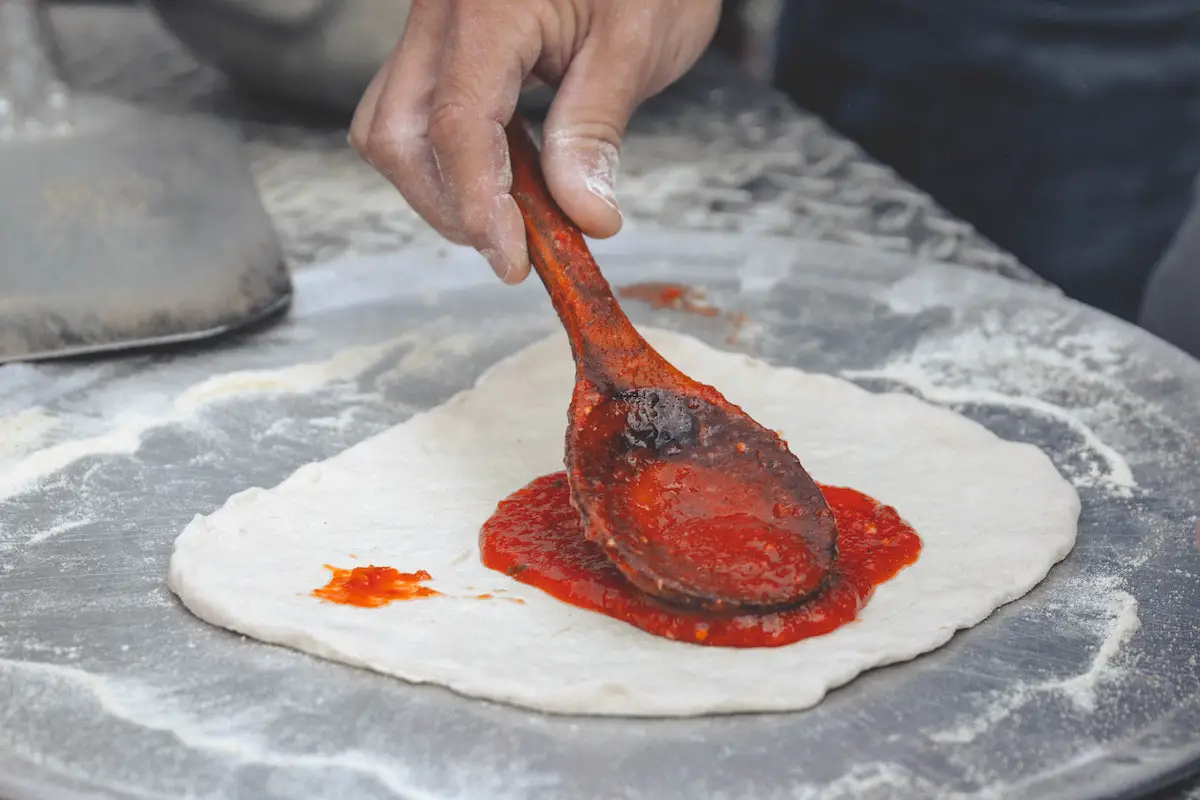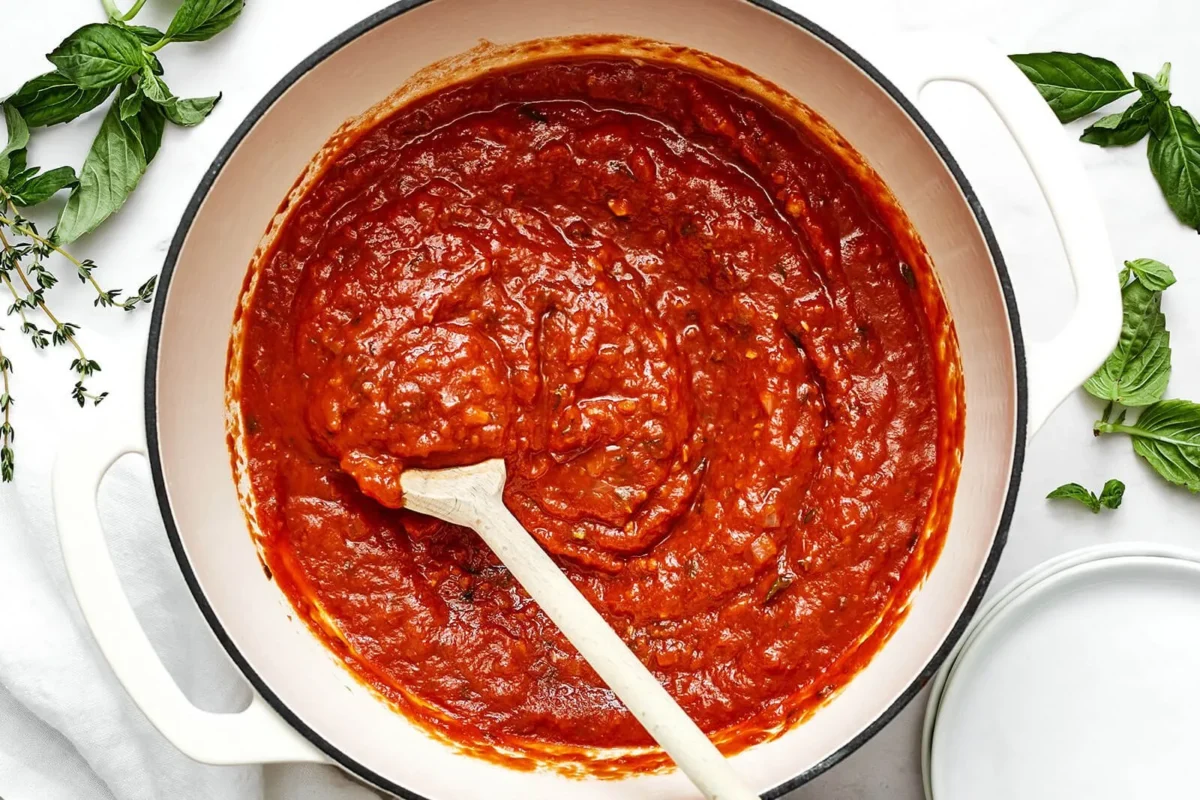Pizza Sauce vs Marinara Sauce – What’s The Difference?
Norah Clark
The main difference is pizza sauce can be described as a creamy tomato sauce created by mixing raw ingredients. It’s not cooked until it’s added to a pizza base. Marinara sauce is cooked before being added to another dish and contains key ingredients other than tomato sauce.
With the variety of tomato-based sauces on the market, keeping track of their distinct flavors can be challenging, especially when they’re all from the same culinary background. Italian cooking is widely known for being influential in food concerning sauces, let alone pizza or marinaras.
When I was first introduced to pizza and marinara sauce, I thought they were the same thing. They’re not – far from it!
Carry on reading to get more interesting information about the difference between the two sauces.
What’s The Difference Between Pizza Sauce And Marinara Sauce?
Similarities between pizza and marinara sauce:
- Both sauces have roots in Italian cuisine.
- Tomatoes are the primary ingredient for both sauces.
- Aromatics like basil and garlic are included in various forms.
- Both have a smooth consistency but are thicker than tomato juice.
- They can be combined with other dishes or incorporated into various recipes.
Differences
Marinara sauce may be made using a pre-made tomato sauce as a base, but it usually has other ingredients and can be prepared entirely from scratch. On the other hand, pizza sauce is a simpler form of tomato sauce.
Another significant distinction lies in the cooking method. Pizza sauce is typically uncooked before being spread on pizza and is only cooked when the pizza is baked. Marinara sauce is prepared, cooked, and blended, making it ready to use without further cooking.
The way these sauces are used also differs:
- While pizza sauce is added before cooking, the marinara sauce can be added afterward.
- Marinara serves as the taste ingredient for pasta dishes, a dipping sauce, or a topping for nachos, among other uses.
- Pizza sauce is best for pizzas and baked casseroles.
Can I Substitute Pizza Sauce For Marinara Sauce?
Since the marinara sauce is made with tomato sauce and pizza sauce is a type of tomato sauce, it is not ideal to use pizza sauce as a substitute for marinara. However, it can serve as a base for creating marinara.
However, marinara can be used as a substitute for pizza sauce, but it may have a more herbaceous flavor and lack the same sweetness. Nevertheless, it is still a viable option if you are stuck!
What Is Pizza Sauce?
As the name suggests, pizza sauce is the base sauce used on pizza crusts. There are various types of pizza sauces, but the original and most common one is tomato-based, which continues to be popular in pizzerias worldwide.
Many people confuse generic tomato sauce with pizza sauce. Hence the term “pizza sauce” is used to differentiate the two. Store-bought tomato sauce often has a processed, watered-down consistency and may contain food coloring agents, preservatives, and artificial flavors.
On the other hand, a high-quality pizza sauce is created using fresh tomatoes and carefully blended to create a smooth, rich sauce. Some seasonings may be added, but there are no preservatives or artificial additives. This type of sauce closely resembles tomato-based pasta sauces.
Since pizza has Italian origins, it is best to follow Italian definitions of “pizza sauce” and their recipes and cooking methods to achieve an authentic and delicious result. A great pizza sauce can significantly enhance the overall taste of a pizza.
Read: The Best Pizza Cutters: Tested & Reviewed By A Chef

Pizza Sauce vs Spaghetti Sauce
The main difference between spaghetti sauce and pizza sauce lies in their consistency and ingredients. Spaghetti sauce has a higher water content due to the crushed tomatoes, resulting in a thinner consistency that coats the pasta evenly.
On the other hand, pizza sauce is made with pureed tomatoes, creating a thicker texture to provide a flavorful layer between the pizza crust and its toppings.
Pizza is an American favorite, making the perfect sauce essential for a successful pizzeria. Using spaghetti sauce on pizza may lead to a thin, soggy base that may be texturally unappetizing.
Spaghetti sauce often contains more herbs, spices, and sometimes meat or vegetables, making it a more complex and hearty option compared to the simpler, more concentrated flavor of pizza sauce.
Both spaghetti sauce and pizza sauce have tomato bases, and their texture, ingredients, and flavor profiles set them apart. So, it’s crucial to use the right sauce for each dish to ensure the best culinary experience.
Pizza Sauce Ingredients
The foundation of pizza sauce is tomatoes. Fresh tomatoes are ideal, but canned tomatoes or canned tomato sauces can be used in a pinch for a fresh-tasting result. If using canned tomatoes, use a mixture of cut and crushed tomatoes. For fresh tomatoes, chop them finely in a blender before creating your sauce.
Sugar (white or brown granulated) is essential for balancing the rawness and acidity of tomatoes. There are alternatives for the best sugar-free pasta sauces, as I found the sauce may taste bland without any sugar.
Seasonings such as salt, freshly ground black pepper, and Italian spice are crucial. Italian seasoning is a blend of dried herbs like oregano, basil, rosemary, and thyme.
Garlic is another vital ingredient. Although garlic flakes can be a good alternative, freshly chopped garlic is the best choice for an authentic Italian flavor.
Additional recommended ingredients include onion or shallots, fennel seeds, parmesan cheese, and olive oil. Finely chopped shallots or onions add texture and a semi-sweet flavor, while parmesan cheese can be an optional ingredient for added richness. Olive oil can be used to thin the sauce if needed and imparts a superior taste compared to other oils like canola or sunflower.
How To Make Pizza Sauce
There are numerous ways to make pizza sauce, but we’ll share our base recipe and preferred ingredients to create a delicious, versatile sauce.
No pre-cooking is necessary for pizza sauce. Some people may cook garlic, onions, and spices before blending, but we find it unnecessary since the sauce will cook with the pizza.
To make the sauce, combine all the ingredients in a blender and blend for a few seconds. For a thinner and smoother sauce, blend for longer.
Our recipe includes garlic, onions, Italian seasoning, parmesan cheese, fresh basil leaves, and fresh tomatoes.
For fresh tomatoes, first, remove the skin by immersing them in boiling water for one minute. Then, chop the tomatoes into pieces and add them to the sauce base.
If using canned tomatoes, simply mix them into the recipe, adding sugar to counteract any acidity or metallic taste.
To preserve your pizza sauce for future use, store it in an airtight container in the refrigerator or freezer.
Characteristics
When prepared correctly, the sauce should be thick and spreadable but not as dense as tomato paste. It should have a vibrant red color and a deep umami aroma.
How To Use Pizza Sauce
Primarily used on pizza, spread an even layer of sauce over the crust before adding toppings and cooking in an oven or over an open flame.
Although typically associated with pizza, this versatile sauce can also be used in pasta dishes, either on its own or combined with other ingredients like meat or vegetables.
Transform your pizza sauce into salsa by adding chilis or hot sauce, red onions, black beans, and extra fresh tomatoes for a chunky, flavorful mixture.
For a creative twist, use fresh pizza sauce instead of tomato juice in a Bloody Mary cocktail recipe. Pizza sauce can also serve as an excellent cooking liquid for meat and vegetables, adding depth and flavor to various dishes.
Can You Use Pasta Sauce for Pizza?
It’s a common question among pizza enthusiasts: can you use pasta sauce for pizza? The answer is yes, with a little bit of tweaking, you can turn pasta sauce into a delicious pizza sauce.
How to Make Pizza Sauce with Pasta Sauce
To start, it’s important to strain the pasta sauce to remove any excess liquid. This step is crucial, as too much liquid can make the pizza crust soggy. Once you’ve strained the sauce, blend it in a food processor or blender until it becomes smooth. This will give you a texture that’s more similar to traditional pizza sauce.
To add flavor, you can season the pasta sauce with herbs like oregano and basil, as well as salt and pepper to taste. For a boost of umami flavor, you can also blend in an anchovy fillet.
What Can I Use Instead of Pizza Sauce?
If you’re looking for alternatives to traditional pizza sauce, there are many options;
- Pesto, for example, is a delicious and flavorful option that pairs well with a variety of toppings.
- Ricotta cheese can also be used as a base, creating a creamy and rich pizza.
- For those who like a bit of heat, sweet chili sauce or buffalo wing sauce can add some kick to your pizza.
- And if you’re looking for something more tangy, barbecue sauce or balsamic glaze can provide a unique flavor profile.
If you make your pizza sauce too spicy: How To Make Chili Less Spicy
The sauce is just one component of making a delicious pizza. Quality dough (ideally not frozen dough), fresh toppings, and the right cooking temperature are all important factors in creating a memorable pizza experience.
So whether you’re using pasta sauce, pesto, or another alternative, experiment with different combinations to find the perfect pizza for you.
What Is Marinara Sauce?
Now that we’ve discussed pizza sauce in-depth, let’s delve into marinara sauce. Although similar, there are notable differences between the two.
Marinara sauce, like pizza sauce, is tomato-based and Italian in origin. However, marinara isn’t always made with fresh tomatoes; it often uses pre-made tomato sauce (sometimes even pizza sauce) combined with other ingredients. All the ingredients are cooked before blending.

Marinara Sauce Ingredients
Marinara sauce is simple to make and requires fewer ingredients, as tomato sauce provides most of the flavor.
The primary ingredient is tomato sauce, which shouldn’t be confused with ketchup, as they have different tastes, production methods, and uses.
Other ingredients include freshly chopped basil leaves, onions, and an abundance of garlic, giving the sauce a more robust flavor than pizza sauce.
Basil and onions contribute to the traditional Italian taste, and without them, the sauce would be classified differently. Some people also add fresh, diced tomatoes for extra texture.
Salt and pepper should be added to taste; however, some tomato sauces may already contain enough seasoning. Be cautious not to oversalt the sauce.
For a hint of tang, consider adding balsamic vinegar to the mix.
How To Make Marinara Sauce
Start by sautéing diced onions in olive oil until translucent. Add garlic and other spices, cooking for a few more minutes to help release their flavors and add depth to the sauce.
Once the aromatics are cooked, incorporate the tomato sauce and simmer for about 10 minutes. Finally, stir in the fresh basil leaves.
Some people prefer to blend their marinara sauce for a smoother consistency without onion pieces, while others enjoy it as is. The final texture is up to personal preference.
How To Use Marinara Sauce
Marinara sauce can be used in various recipes, similar to pizza sauce. However, it offers a wider range of applications.
Marinara can be utilized as a dipping sauce, pasta sauce, or even as a base for salsa. It also works well in dishes like meatballs, ratatouille, or minestrone.
The versatility of marinara sauce is due to its pre-cooked nature, allowing it to be used in recipes without requiring additional cooking.
Frequently Asked Questions
Can You Use Marinara Pasta Sauce For Pizza?
Although marinara sauce has a slightly different flavor profile than traditional pizza sauce, it can still provide a delicious base for your pizza toppings. Marinara sauce may have a more robust flavor due to additional garlic and herbs, but it can be an excellent alternative for those seeking a more complex taste.
Do You Use Tomato Sauce Or Marinara On Pizza?
Traditional pizza sauce is the most common choice for pizza, as it is specifically designed for this purpose. However, you can use the marinara sauce on pizza as an alternative. While marinara sauce has a distinct flavor due to the additional herbs and garlic, it can still work well on pizza, providing a unique and delicious taste.
Is Dominos Marinara Sauce The Same As Pizza Sauce?
Dominos marinara sauce is not the same as their pizza sauce. Although both are tomato-based, they have different flavors and ingredients. Dominos marinara sauce has a more robust taste, with a greater emphasis on garlic and herbs, while their pizza sauce has a milder, slightly sweeter flavor that complements the pizza toppings.










